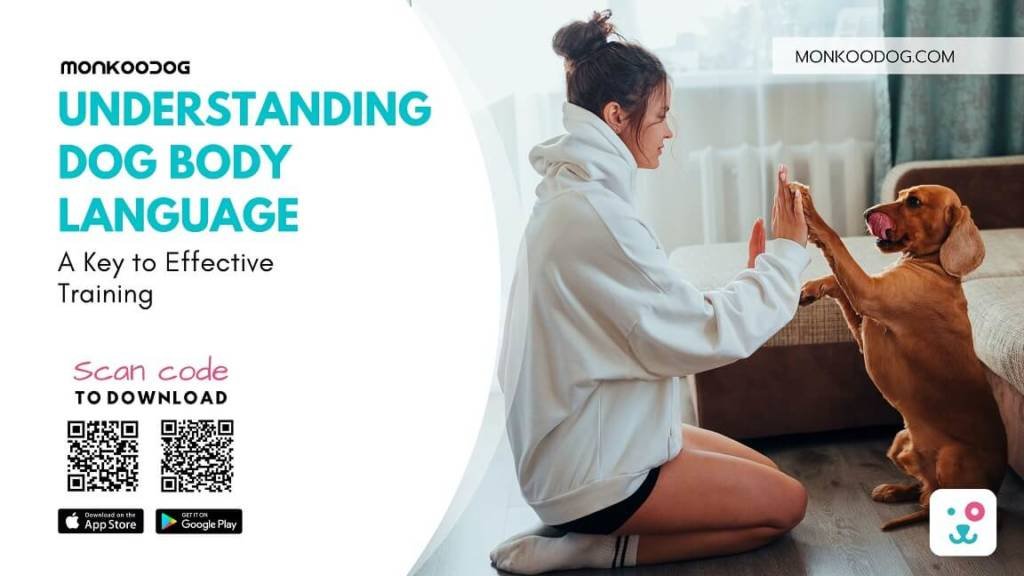Dogs, like people, communicate through body language as well as through vocalizations. If you want to train your dog effectively, it’s important to learn how to read dog body language first. That way, the two of you can communicate well and you’ll see the highest possible chance of success when training.
Today’s post takes a look at some basic dog body language signals, as well as facial expressions and vocalizations. We’ll also discuss how to read physical movements, what this means for training, and a few myths and misconceptions.
Ready for Dog Talk 101? Dive in!
Basic Dog Body Language Signals
If you want to learn how to read dog body language, the best bet is to start with the basics.
Tail Wagging
A wagging tail typically means a dog is feeling positive emotions: happiness, playfulness, curiosity. The faster the wag, the more excited a dog often is. However, dogs may also wag their tails when they are nervous or feeling submissive.
Ear Positioning
Ears can tell you a lot. Forward ears mean curiosity or attention, while ears laid back against the head usually represents aggression or fear. Drooping ears often indicate sadness.
Eye Contact
Common assumptions hold that eye contact always means aggression in dogs. However, while a stark stare can be aggressive, eye contact between a dog and a human is often loving, reassuring, and bonding.
Are you looking for Pet Care Services in Delhi NCR, Then download Monkoodog PetCare App.
Posture

Posture varies widely. We will take a closer look at it under “reading physical movements.” Unfortunately, as in humans, many types of body language have multiple meanings. Getting to know your dog is the best way to discern their feelings.
Understanding Facial Expressions
As with dog body language, dog facial expressions vary widely. When learning how to read dog body language, take these as the basics but modify your understanding once you get to know your dog.
- Fear: When afraid, dogs open their eyes wide and their pupils dilate. Their foreheads often wrinkle and their eyebrows make the “sad” shape.
- Aggression: Aggressive dogs curl their lips, show their teeth, lower their brows, and narrow their eyes.
- Happiness: Happiness on a dog looks much like that on a human. Dogs’ mouths will open and curl upward like a smile, they will have a smooth and unwrinkled forehead, and their eyes will close.
Interpreting Vocalizations
Adjacent to dog body language are dog vocalizations. Learning to read them can help you understand your dog better as well.
- Barking: Barking indicates excitement or alarm. Typically a dog is trying to convey a strong message when they bark, such as getting you to look somewhere.
- Growling: Growling indicates fear, aggression, and mistrust.
- Whining: Whining usually indicates anxiety, nervousness, or fear. In some cases, a dog will use it to indicate extreme excitement or begging.

Reading Physical Movements
The next step in learning how to read dog body language is reading physical movements.
Playfulness
Playful dogs romp around and wiggle a lot, with wagging tails and loose postures. They may use the classic “play bow,” with rump in the air and forelegs stretched out long.
Relaxation
A relaxed dog will walk calmly, lie on its side or back, or sit with a calm or happy expression on its face. Note that relaxation and submission can often look like the same thing, so watch the expression.
Anxiety
Anxious dogs will cringe, lie down, tuck their tails, and hide their faces.
Submission and Dominance
A submissive dog will roll over and often tuck its tail, while a dominant dog will hackle, advance, and look down on the submissive dog.
Combining Body Language and Training Techniques
Once you know how to read dog body language, it makes training much easier. Now you can tell how your dog is feeling and adjust accordingly.
If your dog cringes, backs away, shows fear or distress in their expression, or puts their head down, they’re not having fun. They might be confused because they don’t yet understand a command, in which case, slow down and start again.
With a rescue animal, it’s doubly important to pay attention to body language, as these animals are often easily triggered.

Myths and Misconceptions About Dog Body Language
Dogs, like humans, are multifaceted creatures whose behavior can mean many things. Here are a few of the most common dog body language myths, debunked!
- A raised tail always means aggression: If the tail is combined with snarling and hackling, then watch out for that tail. However, when combined with happy trotting or a play bow, a raised tail is a signal for fun.
- Tummy-up means submission: This common dog posture can also indicate comfort and playfulness as well as anxious submission.
- A tucked tail means it’s safe to approach: Although a tail tuck does signify that a dog is not being aggressive, it also means they’re not happy. Be wary of approaching a dog that is fearful or unhappy.
- An unwavering gaze is aggressive: While staring straight into your eyes can mean a dog is fronting, it can also mean they’re giving you love. It’s all in body language.

A resource for further learning
Understanding the intricate world of dog body language is a journey, and it’s crucial for effective training and building a strong bond with your canine companion. While we’ve covered many essentials in this article, remember that every dog is unique. Their signals and reactions may be as distinctive as they are.
At Helping Fido, we’re dedicated to providing you with more insights, resources, and advice to aid your ongoing learning. Whether you’re grappling with training issues or just looking to understand your furry friend better, our content is tailored to meet your needs.
So, why not extend your learning journey with us? Visit Helping Fido today, and together, let’s make our four-legged friends’ lives happier and healthier. After all, better communication leads to a better relationship with your pooch.





